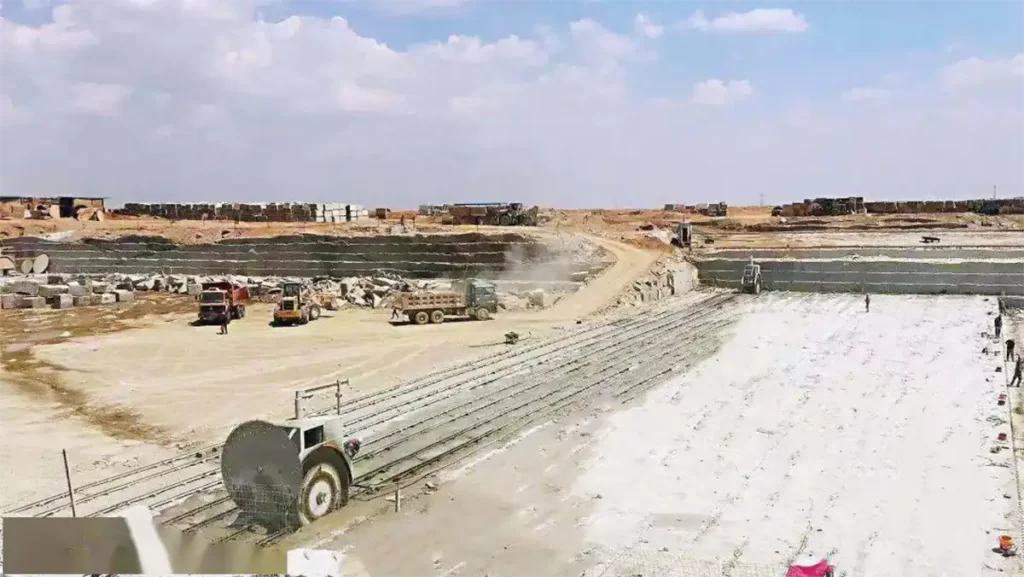
Diamond is currently known as the hardest substance in nature. Legend has it that ancient Egypt used natural diamonds as the original drilling tool during the construction of pyramids, which is the earliest record of human use of diamond tools. As a manufacturer of diamond tools, here Diawe Tools has compiled an article on the history of human use of diamond tools.
Development of Diamond Tools in International
There is a written record that in 1751, someone inserted natural diamonds into the end of a metal pipe as a drilling tool. In 1862, J R. Lesson designed the world’s first surface-mounted natural diamond drill bit with a modern drill bit prototype, with an average diamond particle diameter of 4-5mm. The drill bit is used for manually driven drilling rigs.
In 1864, steam-powered drilling rigs began to appear for drilling blasting holes in the Seni Mountain Tunnel project between Italy and France. A 43mm diameter drill bit embedded with natural diamond was used to drill into hard granite.
Subsequently, humans gradually used diamond drill bits for the exploration of solid mineral deposits. It should be said that the human use of diamond tools began with drilling tools, and its history of use dates is earlier than hard alloy tools. But before this, people could only use natural diamonds. The production cost of such diamond tools was high, and the output of the tools was also limited.
Since the American General Electric Company began to synthesize artificial diamonds in 1953, the types and specifications of diamond tools used by humans have developed significantly. This is a milestone breakthrough for diamond tools.
In 1957, cubic boron nitride (cBN) was synthesized and used in tools, forming a new superhard tool industry that developed rapidly in modern times.
Development of Diamond Tools in China
As a manufacturer of diamond tools in China, Diawe Tools has to mention the history of the development of diamond tools in China.
Diamond Drill Bit
In the ancient civilization of China, during the long historical development from the Stone Age to the Bronze Age and the Iron Age, diamonds were used to make tools, which also started with drilling tools inlaid with natural diamonds.
Before the founding of China, some domestic geological exploration teams had used imported natural diamond drill bits to engage in geological exploration. In the true sense, the development of diamond drill bits in China began in 1960. Since China successfully synthesized artificial diamonds in 1963, it has accelerated the development and application of diamond drill bits. In 1967, China organized a process appraisal for the production of diamond drill bits by the cold press impregnation method, announcing the birth of diamond drill bits with independent intellectual property rights in China. By 1974, China’s original metallurgy, geology, machinery, coal and other industrial departments jointly organized technical appraisal of the production of artificial diamond drill bits by hot pressing and vacuum impregnation. In 1975, China successfully developed a diamond drill bit made by pressureless impregnation that was commonly used abroad. Later, China successfully developed electroplated diamond drill bits.
So far, the four main methods for producing diamond drill bits, namely ⑴hot pressing method, ⑵cold pressing impregnation method, ⑶pressureless impregnation method, and ⑷electroplating method (electroforming method), have all been successfully developed in China.
In geological (solid mineral deposit) exploration, oil and gas well drilling, engineering drilling, etc., diamond drill bits of various specifications, shapes, structures, and matrix formulas independently developed and produced by China are widely used.
Diamond Cutting Tools
As for diamond cutting tools, although they developed later than drilling tools, as a very effective tool for cutting hard and brittle materials, their development speed and scale are indeed the fastest among diamond tools. In the late 1960s, China began to develop diamond circular saw blades, which have been widely used in stone processing since the 1980s.
So far, diamond tools for cutting in China (including circular saw blades, frame saws, wire saws, band saws, etc.) have been widely used in the processing of hard and brittle non-metallic materials (including stone, building materials, concrete, asphalt, refractory materials, etc.) application. Large-scale diamond tool companies have emerged with large production scale, exporting a large number of diamond tools, and sales of 400 to 500 million yuan(¥).
At the same time, China’s ultra-thin drill bits, grinding, and polishing diamond tools, also known as the three major categories of diamond tools, specifically cutting saw blades, drill bits, and grinding wheels, have experienced comprehensive and vigorous development in China. After years of development, China has also become the world’s largest diamond tool production capacity because of the supply chain advantages.
According to the statistics from the Superhard Materials Branch(Industrial Diamond Association, abbreviated as IDA) of the China Machine Tool & Tool Builders’ Association, the sales quantity, sales amount, and average unit price of the three major categories of diamond tools in China reached 1.5 billion yuan(¥) in 2011. These products are mostly used in the domestic market, and many of them are exported to foreign countries. The quantity and geography of exports continue to expand, and some middle and low-quality products are increasingly recognized by international customers. According to Chinese customs statistics, in 2011, Chinese diamond tools were exported to nearly a hundred countries and regions, totaling about 40000 tons (the statistical unit used by Chinese customs).
| Sales Data Statistics of Three Major Types of Diamond Tools for Key Chinese Enterprises in 2011 | ||||||
|---|---|---|---|---|---|---|
| Three Major Diamond Tools in China | Sales Volume | Sales Amount | Unit Price | |||
| Quantity/10,000 Pieces | Growth Rate/% | Amount/100 Million Yuan(¥) | Growth Rate/% | Price/Yuan(¥) | Growth Rate/% | |
| Diamond Saw Blade | 6652 | 23 | 10.36 | 21.2 | 15.6 | -1.52 |
| Diamond Drill Bit | 209 | 3.8 | 1.01 | 9.9 | 48.2 | -5.58 |
| Diamond Grinding Wheel | 129 | 74.6 | 2.81 | 63.1 | 218.3 | -7.53 |
Current Status of Diamond Tools
Rapidly Developing Technology
Diamond saw blades are the main product in diamond tools. From the 1970s to the early 1990s, high-frequency brazing saw blades were commonly used. In the 1980s, one piece of Φ1600mm granite saw blade could cut granite block with a Shore hardness of 80-90, roughly 100-120 ㎡. It can cut 4-6 ㎡ in one shift, and the price of a saw blade at that time was 7000-8000 yuan(¥).
A full new granite saw blade of Φ1600mm is now priced at only 1800-2000 yuan(¥). It can cut 200-240 ㎡ of the same granite block, and can cut 20-24 ㎡ in one shift. Its service life and cutting efficiency have increased by 1 and 3 times, respectively, while the price has decreased by 70%.
This change reflects the astonishing development of artificial diamond tools, even this trend is still ongoing.
Similarly, for oil and gas well drilling and extraction involving energy, earlier drill bits were expensive, while using hard alloy roller drill bits resulted in low drilling efficiency and short service life. In recent years, polycrystalline diamond composite drill bits have achieved excellent drilling results in soft and medium hard formations, with better cost-effectiveness than traditional single-crystal diamond drill bits.
As a technically challenging oil and gas well drill bit, this technological advancement also reflects the rapid development of diamond tool manufacturing technology.
In summary, diamond tools have gone through a development path from scratch, from small to large, from scattered to intensive, and from product to industry. At present, diamond tools have become the most important material in the processing of hard and brittle non-metallic materials.
Wide Application Range
Diamond tools can not only process non-metallic materials(natural stone, ceramic, concrete, artificial stone, asphalt, glass, etc.)but also metal materials and modern advanced composite materials. In recent years, the diamond tool industry has increased the research and development of polycrystalline diamond (PCD), polycrystalline diamond composite (PDC), and chemical vapor deposited diamond film (CVD), especially in developed countries such as Japan, Europe and America. Encouraging progress has been made, and it will play an increasingly important role in the high-precision, high-speed, energy-saving processing of difficult-to-machine materials such as metals and composite materials.
CVD stands for Chemical Vapor Deposition, which can deposit both diamond and cubic boron nitride. CVD technology can deposit multiple grades of pure diamond and single crystal diamond, which can be thin films or thick films (>0.5mm).
In the 1980s, countries such as Europe, America, Japan, and South Korea sparked a wave of CVD research and development. Enterprises in these countries produced CVD film materials that were close to or reached the performance of a single diamond, and cutting tools or other functional products made from the film materials could already be industrialized. According to research by the BBC of the United States, the market for CVD-based film materials (including a few classified diamond DLC films and cBN films) reached 530 million US dollars in 2007, and 1 billion US dollars in 2012.
PDC and PCD are diamond polycrystalline sintered materials, with substrates called PDC, abbreviated as composite sheets, and without substrates called PCD, abbreviated as polymers. The market consumption of PDC and PCD in 2007 was 490 million US dollars. They are currently mainly used as drilling teeth, drawing dies, and cutting tools for drilling tools, and cutting tools are currently highly efficient, high-precision, and irreplaceable in low-carbon and environmentally friendly machining technology.
The following chart shows the percentage of PDC and PCD currently used in the processing industry and processed object materials in Europe, America, Japan, and South Korea. It is evident that over half of PDC and PCD products are used in the automotive processing sector, and 60% of products are used to process non-ferrous metals such as Al-Si, Al-Mg, Ti alloys, etc.
Part A:

| Industrial Application Percentage of PDC and PCD | |
|---|---|
| Application Industry | Percentage(%) |
| Aerospace Industry | 4% |
| Drilling of Oil and Gas Wells | 6% |
| Bearing Industry | 20% |
| Automotive Processing Industry | 54% |
| Others | 16% |
Part B:

| Material Percentage of PDC and PCD Processing Objects | |
|---|---|
| Material Name | Percentage(%) |
| Wood | 30% |
| Nonferrous Metals | 60% |
| Other Metals | 10% |
In the 1980s, China began the research and development of CVD diamond films, PCD, and PDC. Although the development was relatively slow in the middle stage, entering the 21st century, the development momentum was strong, and many enterprises, research institutes, and higher education institutions saw their great development prospects and entered this field one after another.
At present, the main manufacturing methods for CVD diamond films include hot wire plasma technology, microwave plasma technology, and DC plasma jet technology. The most widely used hot wire plasma technology in China currently has a maximum diameter of 120mm, while the maximum diameter that can be manufactured internationally is 180mm. This method has low equipment investment, but a slow growth rate, uneven temperature field, high internal stress, and poor impact toughness. Recently, relevant Chinese units have made many improvements, which can produce a pure diamond thick film with a diameter of 110mm, a thickness of 0.6-1mm, a growth speed of 10-15 μm/h, uniform performance, low internal stress, a bending strength of 1100MPa, the wear ratio of no less than 300000 without support.
The research and development of PCD and PDC for cutting tools are also flourishing. At present, with the large-scale development of diamond synthesis equipment (cylinder diameter up to 1000mm), careful design of assembly structures, and substantial mastery of polymerization processes, it is now possible to produce composite sheets with a diameter of 45. All physical mechanical properties and composite properties (wear ratio, thermal stability, impact strength) can meet the requirements for making diamond cutting tools.
However, it should be noted that CVD film, PCD block, and PDC block are only raw materials for diamond tools. The production of diamond tools still requires four processes: polishing, cutting, welding, and edge grinding of the raw materials. These processes require high technical requirements, and currently, each technical link is still weak, and a complete industrial chain has not yet been formed. Moreover, the matching of cutting tools with processing materials and parameters, forming a series of diamond cutting tools, and achieving a market mechanism that allows customers and manufacturers to better understand each other and have a targeted approach, still requires the industry’s hard work.



